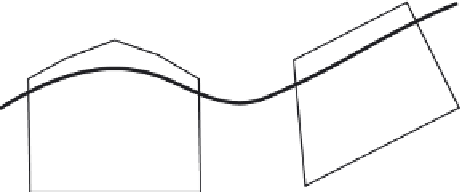Graphics Reference
In-Depth Information
Initial configuration
Surface distorted after joint articulation
FIGURE 4.30
Using FFD to deform a surface around an articulated joint.
the figure. Animation of the FFD control points is produced by modeling the lattice with springs,
dampers, and mass points. The control points of the lattice can then respond to gravity as well as kine-
matic motion of the figure. To respond to kinematic motion, the center of the FFD is fixed relative to the
figure's skeleton. The user kinematically controls the skeleton, and the motion of the skeleton moves
the center point of the FFD lattice. The rest of the FFD lattice points react to the movement of this center
point via the spring-mass model, and the new positions of the FFD lattice points induce movement in
the surface of the figure. This approach animates the clothes and facial tissue of a figure in animations
4.4
Three-dimensional shape interpolation
Changing one three-dimensional shape into another three-dimensional shape is a useful effect, but tech-
niques are still being developed for arbitrary shapes. Several solutions exist that have various limita-
tions. The techniques fall into one of two categories: surface based or volume based. The surface-based
techniques use the boundary representation of the objects and modify one or both of them so that the
vertex-edge topologies of the two objects match. Once this is done, the vertices of the object can be
interpolated on a vertex-by-vertex basis. Surface-based techniques usually have some restriction on the
types of objects they can handle, especially objects with holes through them. The number of holes
through an object is an important attribute of an object's structure, or
topology
. The volume-based tech-
niques consider the volume contained within the objects and blend one volume into the other. These
techniques have the advantage of being less sensitive to different object topologies. However, volume-
based techniques usually require volume representations of the objects and therefore tend to be more
computationally intensive than surface-based approaches. In addition, the connectivity of the original





























































Search WWH ::

Custom Search